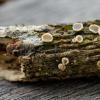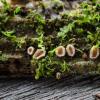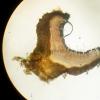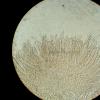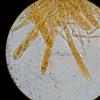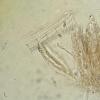
26-12-2025 21:19
Arnold BüschlenPithyella chalaudii Priou. Ist als Bryoparasit in

21-12-2025 09:32
Hello.A tiny ascomycete found embedded in wood in

18-12-2025 21:17
Pol DebaenstThe identification took me to Byssonectria deformi

24-12-2025 17:08
Hulda Caroline HolteHello, I have found this propoloid ascomycete on

21-12-2025 21:32
Pol DebaenstHello, Garden, Burgweg 19, Veurne, BelgiumOn 10/1
 http://mushroomobserver.org/230585
http://mushroomobserver.org/230585Trichopeziza?
Only these poor macro and micro images to go on. No magnifications, no certainty on scope calibration or mounting mediums.
Any and all help greatly appreciated.
-myxomop

I don`t know if it is help and you are right: there is few information (and Costa Rica is far from Europe) - but I see some similarity of your fungus with Perrotia tricolor.
Surely Zotto will contradict.
Regards from Lothar

this looks like something interesting for me. Does this collection exist or only the photos?
The paraphyses have a rough surface by some exudate which is known in a few members of Trichopezizoideae, but not from typical species of Trichopeziza. For instance I saw this in a collection of Trichopezizella barbata and in a number of apparently undescribed taxa. Maybe these deserve a genus of their own, and we are presently trying to find out about it by sequencin a number of species.
Your collection could also be compared with the genus Erioscyphella in which a lot of tropical species belong, such as E. abnormis but I don't see a species with such spores. You don't have a photo of the hairs?
Zotto

Proliferodiscus tricolor is similar, yes, but has cylindrical non-protruding paraphyses without these deposits on them.

I'm afraid these are the only images. Thank you for your comments and suggestions, despite the lack of more information.
Best,
-Danny

Sessile, up to 2mm in diam.
Asci ~115-150µm x 10-15µm, 8-spored, inoperculate, inamyloid. Paraphyses ~175µm x 5µm. Hairs ?µm x 4-5µm, multi-septate.
Spore Measurements:
15-22.5µm x 5-7.5µm (x=19.66µm x 6.6µm, m=20, s=1)
22.5x7.5
21.5x7.5
22.5x7.5
21.5x7.5
21.5x7.5
17.5x7.5
22.5x7.5
20x6.5
18.5x6.5
18.5x6.5
15x5
20x6.5
18.5x5
17.5x5.5
17.5x5
17.5x5.5
20.5x7.5
20x7.5
19x5.5
20.5x7
I'm guessing I did not get hair length measurements because they were enormously long.
Does any of this get us closer to an ID?
My continued thanks,
-Danny

If really inamyloid, your fungus indeed comes close to my T. perrotioides, except for the much larger spores. A pity that it is not preserved.

I can't find a reference to T. perrotioides. Is this a published name? Is it a Trichopeziza or Trichopezizella?
Also, I believe at least some of the micrographs represent fresh, living material, though I cannot 100% confirm this.

If some spores or paraphyses were alive the contents are not very good to see. Good is to have free spores that were forcibly ejected from the living asci, then you have a very constant and taxonomically significant arrangement of guttules.
